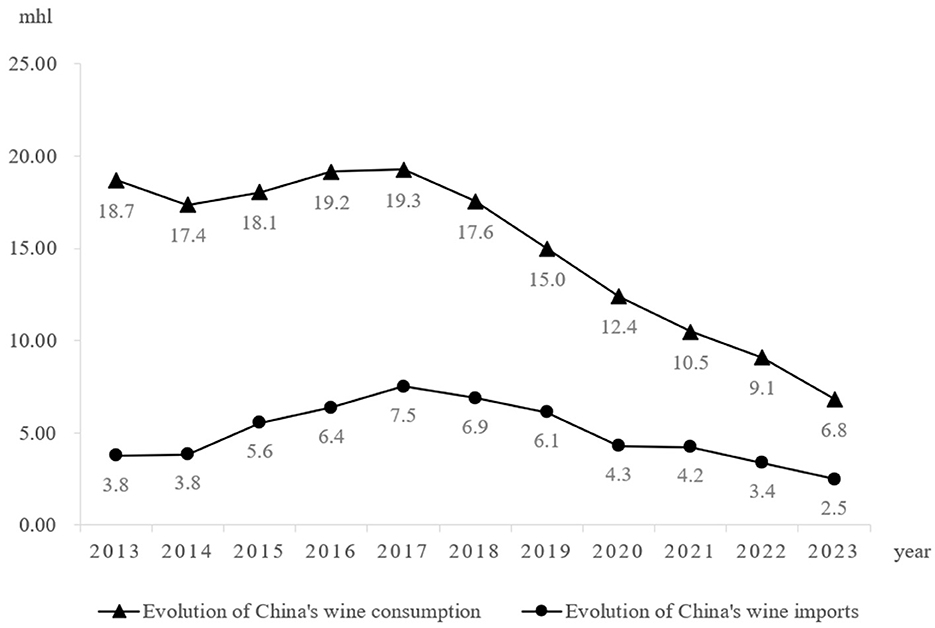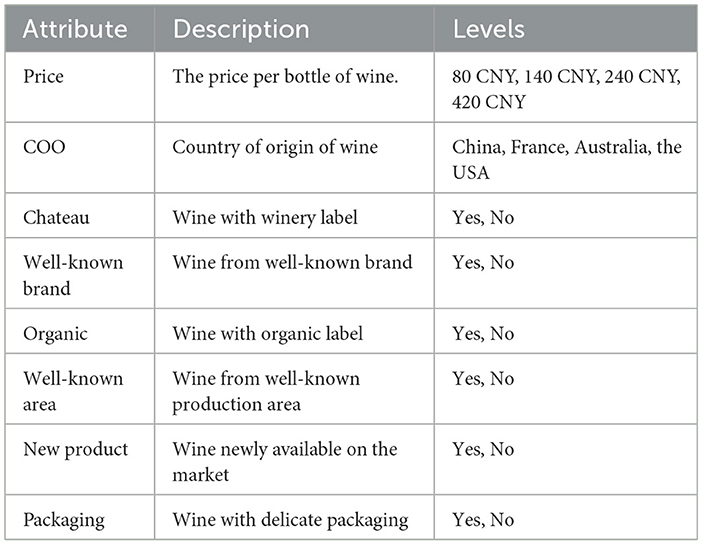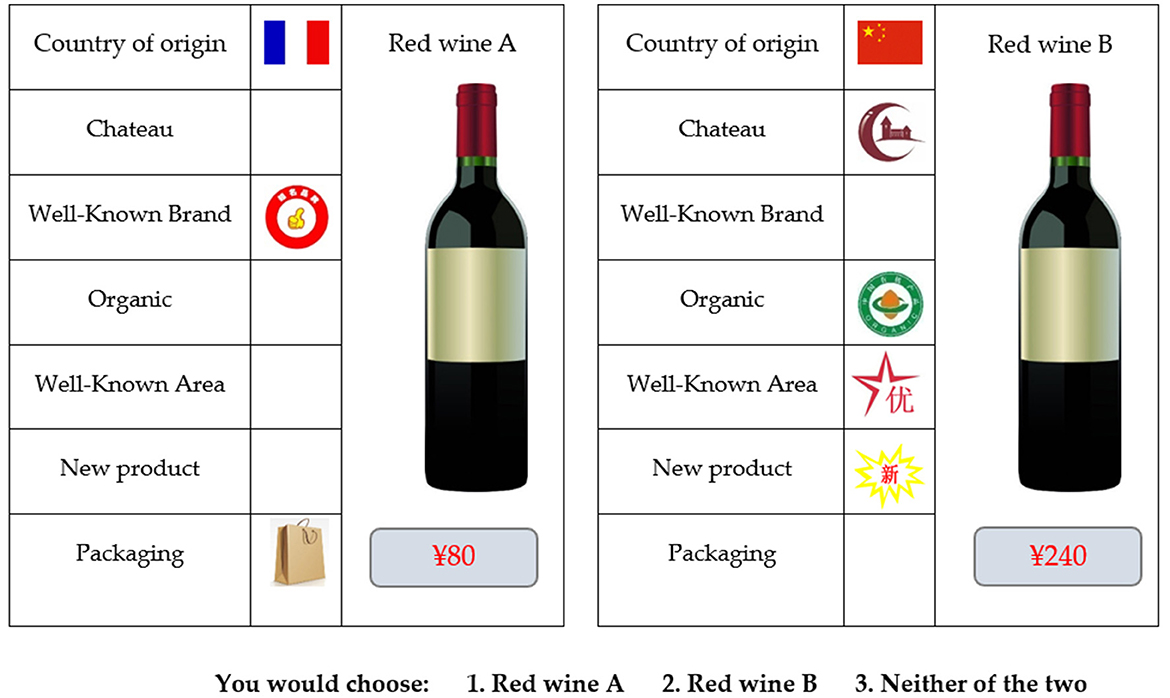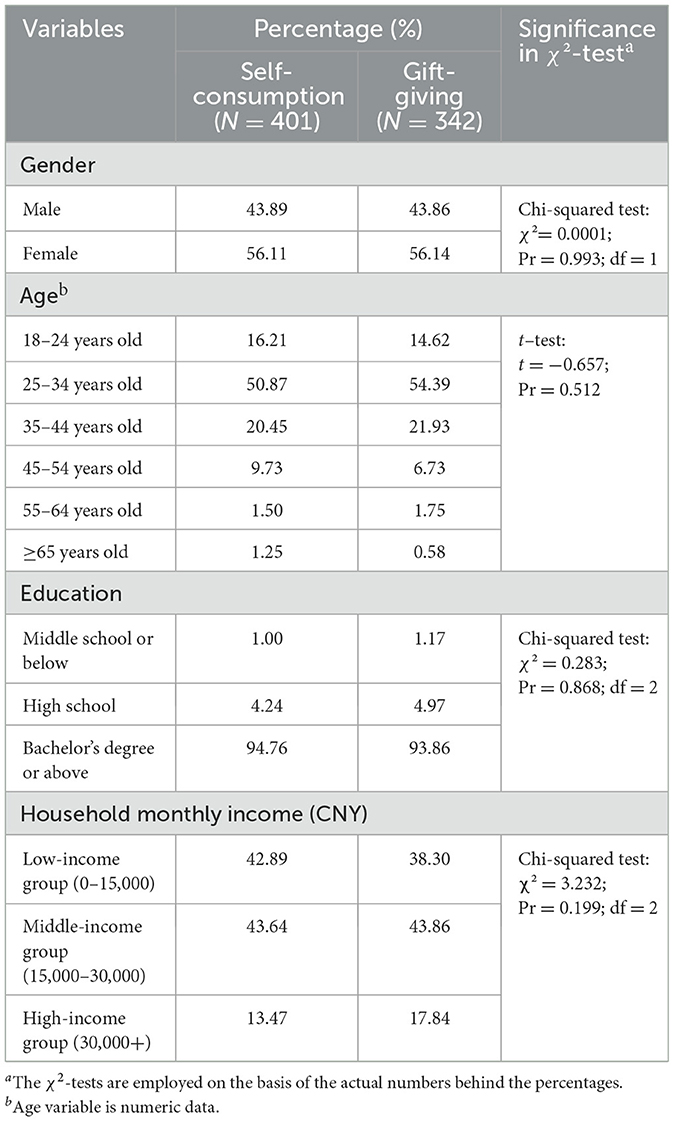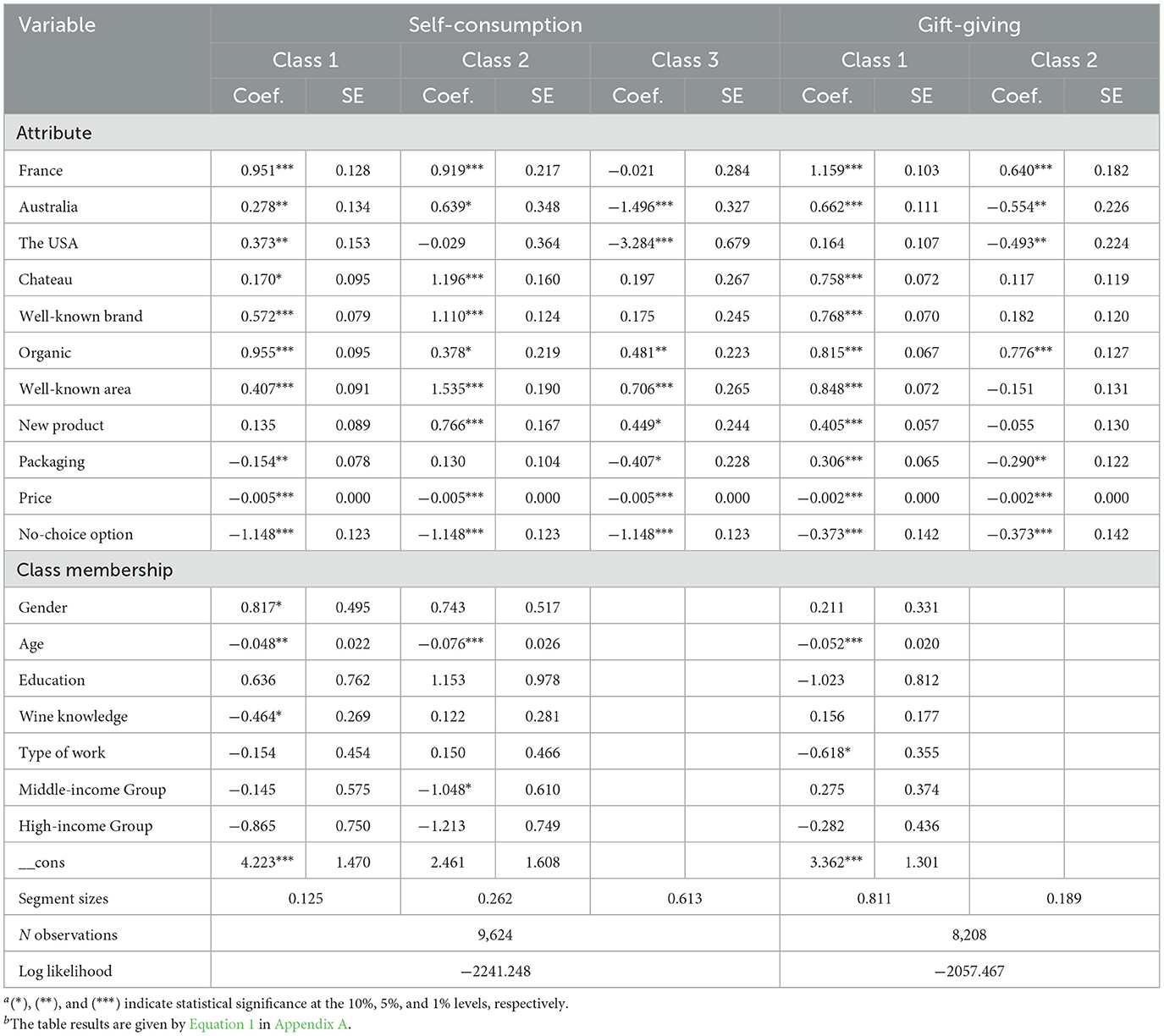- School of Agricultural Economics and Rural Development, Renmin University of China, Beijing, China
China's wine market is increasingly driven by a demand for sustainability, influenced by diverse consumer behaviors and preferences. This study investigates sustainable wine preferences across self-consumption and gift-giving contexts in two western second-tier Chinese cities, using a choice experiment and Latent Class Model (LCM). Through a three-step analysis—evaluating the relative importance of attributes, marginal effects, and willingness to pay—we identify five distinct consumer segments based on two independent samples: “Price-Sensitive Consumers,” “Well-Known Area Followers,” and “China-Wine Enthusiasts” for self-consumption, and “Packaging Lovers” and “Organic Supporters” for gift-giving. Preference differences reveal distinct patterns relevant to sustainability. For instance, “China-Wine Enthusiasts” prefer local wines, supporting regional branding as a low-carbon option. “Organic Supporters” exhibit high WTP for organic labels, while “Packaging Lovers” favor delicate packaging, suggesting a need for more sustainable packaging alternatives. These findings highlight the importance of tailoring marketing strategies to consumer segments and consumption contexts within China's evolving wine market.
1 Introduction
China stands as a critical market in the global wine industry, being the largest consumer and importer of wine in Asia, and ranking ninth in consumption and tenth in imports worldwide (Anderson and Wittwer, 2015; Anderson, 2020, 2023; OIV, 2024). As shown in Figure 1, China's wine consumption and imports have experienced fluctuations over time, with recent declines linked to one-off events like the COVID-19 pandemic and global inflationary pressures (Anderson, 2023; OIV, 2024). Nevertheless, the resilience of China's wine market, driven by evolving consumer preferences and untapped potential, highlights its capacity for growth, particularly in sustainable wine consumption (Chi et al., 2021; Dong and Gao, 2024).
Another distinctive feature of China's wine market is its context-specific consumption, primarily divided into self-consumption and gift-giving (Hu et al., 2008; Qing et al., 2015; Seidemann et al., 2017). Unlike Western markets where wine is often paired with daily dining, Chinese consumers frequently purchase wine for symbolic purposes, such as strengthening social networks (“guanxi”) and enhancing “face” culture (Camillo, 2012; Qing et al., 2015; Yang and Paladino, 2015; Wang, 2017). It is valuable to explore these differences in the context of Chinese culture. Notably, gift-giving dominates these scenarios, with 86% of surveyed consumers purchasing wine as gifts and 47% choosing wine in the past year, reflecting its symbolic role in social interactions (HKTDC, 2018, 2020). These distinct consumption contexts underscore the need to explore preference variations in China's wine market.
Understanding how consumer preferences vary across these distinct contexts is critical for advancing sustainable wine marketing in China. Yet existing studies in the Chinese context often fail to distinguish between usage situations, assuming consumer preferences as uniform across self-consumption and gift-giving occasions. At the same time, traditional methods often fail to reflect the trade-offs consumers face when choosing wine. To address these gaps, this study applies a Discrete Choice Experiment (DCE) to compare preferences across scenarios and identify distinct consumer segments, offering targeted marketing strategies.
2 Literature review
2.1 Application of DCEs in wine market
Discrete Choice Experiments (DCEs) are widely used to elicit consumer preferences through the estimation of marginal willingness to pay (WTP) for specific attributes (Louviere et al., 2000; Train, 2009). Compared with other stated preference methods (e.g., ratings, rankings, contingent valuation), DCEs require participants to choose a product from a set of alternative products with different attributes, closely simulating real-world decision-making scenarios (Lusk and Schroeder, 2004; Hensher et al., 2015). This method not only provides the WTP for attributes but also calculates the relative importance of attributes. Richer information offers deeper insights into consumers' trade-offs between different attributes (Adamowicz et al., 1998; Hoyos, 2010).
In recent years, researchers have increasingly used DCEs to explore what influences wine consumers' decisions. Prior studies have examined the effects of price (Mueller et al., 2010; Nassivera et al., 2020), country of origin (Williamson et al., 2016; Escobar et al., 2018; Tait et al., 2019), organic label (Schäufele and Hamm, 2017; Di Vita et al., 2019; Janssen et al., 2020), branding (Di Vita et al., 2019), and region (Lockshin et al., 2006; Chamorro et al., 2015). However, these factors matter differently across countries and cultures, showing the value of studies tailored to specific regions (Sáenz-Navajas et al., 2014; Zanchini et al., 2024).
In China's wine market, DCE applications remain limited and have primarily examined conventional attributes such as price and country of origin (Palma et al., 2016; Williamson et al., 2016; Corsi et al., 2017b; Gonçalves et al., 2020). As a result, attributes linked to sustainable consumption, such as organic labels, packaging design, and other reputation indicators have often been overlooked. For example, packaging plays an important role in gift-giving scenarios (Yang and Paladino, 2015), while organic certification matters to consumers concerned with health or environmental issues (Lu et al., 2019; Dong and Gao, 2024). This gap offers a chance to better understand how a broader range of attributes influence consumer choices in China (Yang and Paladino, 2015; Williamson et al., 2016; Lu et al., 2019; Dong and Gao, 2024).
2.2 Differences in wine preferences across consumption contexts
Consumer wine preferences often vary depending on the specific consumption context (Kallas et al., 2013; Dominici et al., 2019; Bruwer et al., 2013; Corsi et al., 2017a; Christian and Wang, 2022; Brochado et al., 2024). Prior research has largely focused on a single purchase purpose. These studies generally examine wine choices made in either everyday situations—such as casual drinking or dining (Xu and Zeng, 2014; Hu and Baldin, 2018; Aqueveque, 2022)—or, less commonly, in special occasion contexts such as celebrations or formal events (Kallas et al., 2013; Dominici et al., 2019). However, few studies have compared how consumer preferences vary across these different contexts (Carsana and Jolibert, 2017; Dobele et al., 2018), especially in China, where gift-giving plays a prominent cultural and social role (Yang and Paladino, 2015; Seidemann et al., 2017). Some existing studies have observed that the ranking of choice drivers differs between self-consumption and gift-giving contexts, but these differences cannot be statistically compared due to the methodology adopted (Xu et al., 2014; Qing et al., 2015; Huiru et al., 2018).
To the best of our knowledge, only one study to date has applied a DCE to compare wine preferences across personal consumption and gift-giving contexts—namely, the work by Boncinelli et al. (2019). Their study, conducted in the Italian market, found significant variations in attribute importance: while geographical indication (GI) was the most relevant attribute for personal consumption, brand and organic certification were more influential in gift-giving scenarios. Despite its methodological rigor and valuable insights, the study focused only on heterogeneity within the gift-giving context and treated personal consumption as a homogeneous group. Moreover, their DCE design did not include attributes such as packaging or other reputation-related cues that might play a crucial role in different scenarios (Qing et al., 2015; Corsi et al., 2017a). Building on their work, our study extends the cross-contextual comparison to an emerging market—China—where gifting has unique cultural significance. Moreover, we explore consumer heterogeneity in both contexts and incorporate a broader set of attributes. This allows us to offer a more nuanced understanding of how wine preferences shift across occasions and consumer segments.
This study offers three primary contributions. First, it broadens the use of DCEs in the Chinese wine market by including underexplored sustainability-related attributes such as packaging, organic labels, and reputation cues. Second, it offers a structured comparison of consumer preferences across self-consumption and gift-giving scenarios, highlighting context-specific drivers. Third, it uncovers heterogeneity in preferences using Latent Class Models (LCMs), offering practical insights for developing sustainable and targeted marketing strategies.
3 Materials and methods
3.1 Analysis framework
This study explores consumer preferences for sustainable wine in China's self-consumption and gift-giving contexts. To achieve this, we conducted two purchase scenario choice experiments (CEs), randomly assigning respondents to either a self-consumption or gift-giving scenario. Each respondent completed only one CE task, ensuring that both scenarios were independent subsamples. Both experiments used the same attributes for direct comparison. The analysis segment consumers based on preference heterogeneity and evaluate key attributes through three indicators: the relative importance of the attributes (RI), marginal effects (ME), and willingness to pay (WTP). This framework offers actionable insights for designing segment and scenario-specific marketing strategies that promote sustainable wine consumption.
3.2 Experiment design
Since red wine makes up 92% of China's wine consumption (OIV, 2023), this study created a virtual red wine product for the experiment. We conducted two experiments, CE1 for personal use and CE2 for gift-giving.
The attributes and levels (Table 1) were selected based on literature. For the price attribute, Mu et al. (2017) found that gift wine under 450 CNY can cover 85% of Chinese consumers in Beijing. We conducted a pre-investigation, which showed that the price range of 80–420 CNY was appropriate for reflecting real market pricing in the second-tier cities of Chengdu and Xi'an. Country of origin (COO) matters, like French wines often chosen for gifts (Xu et al., 2014). The levels included both traditional and emerging wine-producing regions. The chateau attribute reflects a winery's heritage, valued by consumers seeking quality. Similarly, well-known brand and well-known area labels provide additional reputation cues that help consumers in the absence of direct product experience. Reputation indicators, including COO, chateau, well-known brand, and well-known area allow for comparison of how consumers weigh different forms of reputational capital in distinct purchasing situations. Organic attribute reflects consumer concerns about quality, environmental and health-conscious values (Chi et al., 2021). The “new product” attribute was introduced as an exploratory attribute to assess consumer openness to innovation in wine offerings. It captures potential interest in novelty or differentiation. In this study, the packaging attribute refers to the outer packaging of wine, such as delicate bags or boxes, not in the broader sense of label design, bottle characteristics (e.g., shape or closure) (Chamorro et al., 2020; Aqueveque, 2022). In China's gift-giving culture, delicate packaging is likely to play a significant role, whereas it is less relevant in self-consumption contexts.
To reduce respondent cognitive burden, we employed a fractional factorial design maximizing D-efficiency (79.8%), generating 16 choice sets divided into two blocks of 8 sets each, using SAS 9.4 (Louviere et al., 2000; Street and Burgess, 2007). Each choice set included two wine alternatives and a “neither of the two” option. Including a “neither of the two” option allowed respondents to make more realistic decisions when dissatisfied with the presented alternatives (Dhar, 1997; Dhar and Simonson, 2003). Attributes were dummy coded for non-price variables, and choice sets were randomized to avoid ordering effects. Respondents were instructed to imagine purchasing wine online, with a “cheap talk”1 script used to minimize hypothetical bias (Farrell and Rabin, 1996; Carlsson et al., 2005). An example choice set (Figure 2) and detailed attribute descriptions were provided to ensure clarity. They were also informed that, except for the attributes listed in the CEs, no differences existed among other attributes.
3.3 Data
This research was approved by the Institutional Review Board of Renmin University of China. Participation was voluntary, and informed consent was obtained from all respondents prior to data collection. The data was collected by Sojump (www.sojump.com), a widely used Chinese survey platform comparable to Qualtrics, between 20 June and 30 July, 2023. The survey targeted residents of Chengdu and Xi'an, two prominent second-tier cities in western China, selected to investigate emerging wine markets and their sustainable consumption trends beyond the frequently studied first-tier and eastern coastal cities (Xu et al., 2014; Gonçalves et al., 2020; Dong and Gao, 2024). Online surveys were chosen for their cost-effectiveness, simple execution and quick data collection, making them an effective tool for consumer research, with studies validating their data quality as comparable to other methods (Lindhjem and Navrud, 2011; Nielsen, 2011; Windle and Rolfe, 2011).
Participants were drawn from Sojump's extensive respondent pool of over 2.6 million individuals across China. To ensure relevance, eligibility screening required participants to be at least 18 years old and to have either consumed wine at home or purchased it as a gift within the preceding year. Geographic review uses IP address verification, restricting participation to Chengdu and Xi'an residents. Surveys were designed to be as brief as possible, each lasting ~10–15 min, which is the ideal length of time for online surveys (Revilla and Höhne, 2020).
To ensure the reliability of responses, rigorous quality controls were implemented. First, a randomized distribution process assigned respondents to either the self-consumption or gift-giving context to capture distinct behavioral drivers. Second, clear introductions to attributes and choice sets were provided via text and images. Third, multiple screening questions were employed to filter out inattentive responses, including “trap” questions2 (Gao et al., 2016a,b), low probability screening questions3 (Jones et al., 2015), and consistency questions4.
3.4 Sample characteristics
An equal number of respondents (500 per city, total N = 1,000) was initially recruited from Chengdu and Xi'an, with 250 respondents per city assigned to each of the self-consumption and gift-giving surveys, resulting in 401 valid self-consumption and 342 valid gift-giving responses after screening (efficiency rates: 80.2% and 68.4%). As shown in Table 2, there are no significant socio-demographic differences between the two groups, suggesting that variations in sustainable wine preferences stem from behavioral drivers tied to consumption contexts rather than demographic factors.
Table 2 reveals a sample with a slightly higher proportion of females than males, predominantly aged 25–45, mostly educated to Bachelor's level or above, and concentrated in the lower-middle income range, consistent with prior studies on Chinese consumers (Yu et al., 2009; Xu and Zeng, 2014; Masson et al., 2017; Yu and Ruimei, 2019; Gonçalves et al., 2020; Mackenzie et al., 2024). Similar to other empirical studies using online surveys, the sample in this study is highly educated (Zhou et al., 2017; Ding et al., 2022), but several comparative studies confirm the data's validity despite bias (Nielsen, 2011; Windle and Rolfe, 2011).
In addition, some subtle trends between the two groups are noteworthy. The gift-giving group has a slightly higher proportion of high-income respondents (17.84% vs. 13.47%) and a marginally higher share of younger respondents aged 25–34 (54.39% vs. 50.87%). These trends, though not statistically significant, may suggest that gift-giving behaviors are slightly more prevalent among higher-income and younger consumers, potentially influencing preferences for attributes like packaging or organic labels.
Figure 3 illustrates distinct differences in wine-related behaviors between the self-consumption and gift-giving groups. The self-consumption group consumes wine more frequently (19.45% over twice weekly vs. 11.99% for gift-giving group), purchases wine more often, and includes a greater proportion of novice drinkers. In contrast, gift-giving respondents tend to have longer wine-drinking experience and greater product knowledge, likely enhancing their ability to choose wine gifts. Notably, both groups report steadily increasing trends in wine consumption.
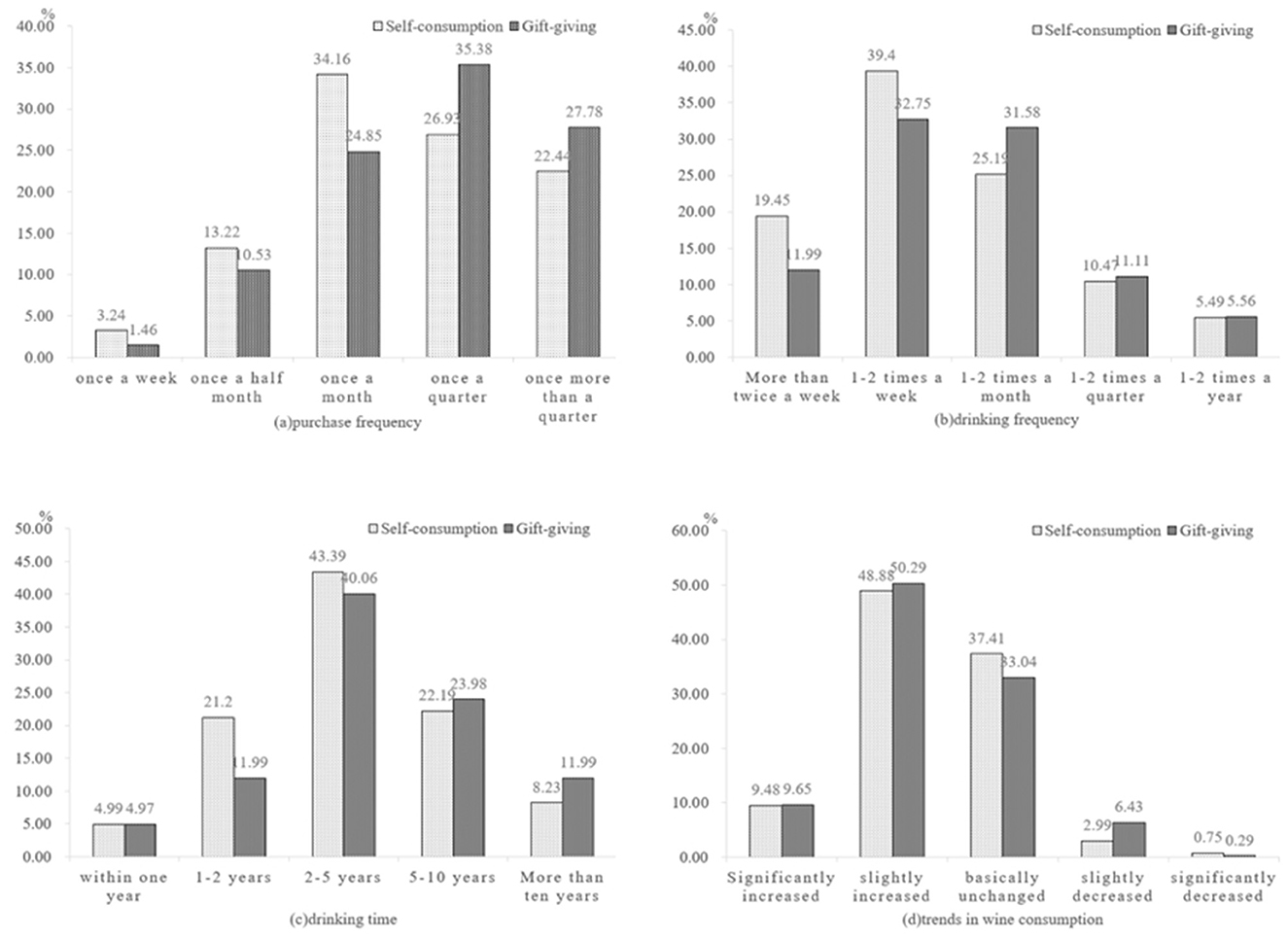
Figure 3. Comparison of consumption habits and buying behavior across self-consumption and gift-giving contexts.
3.5 Econometric analysis
The Latent Class Model (LCM) was used to analyze respondent choices, modeling utility for each wine alternative as a function of price and non-price attributes, including COO, chateau, well-known brand, organic, well-known area, new product and packaging. Within each class, the LCM assumes a conditional logit structure, estimating distinct preference parameters across segments and probabilistically assigning respondents to classes based on choice patterns (Louviere et al., 2000; Greene and Hensher, 2003). To interpret model results and compare preferences across groups, we derived three indicators:
3.5.1 Relative importance (RI)
This measures the proportionate contribution of each attribute to the overall utility variation in each class. A higher RI indicates that an attribute has a stronger impact on decision-making, reflecting greater preference or sensitivity to that attribute. This helps identify which attributes are prioritized by different consumer groups.
3.5.2 Marginal effects (ME)
This assesses how changes in wine attributes affect the likelihood of choosing a specific wine. For price, ME shows how sensitive consumers are to price changes, while for non-price attributes (e.g., organic label), it measures the change in choice probability when the attribute is present vs. absent. This analysis highlights the strength and direction of consumer responses to attribute changes, guiding wineries toward attributes that drive sustainable consumption.
3.5.3 Willingness to pay (WTP)
This derives from the trade-off between price and other attributes, indicating the monetary value consumers place on specific wine attributes. Specifically, a higher WTP means either they derive more satisfaction from the attribute, or they are less sensitive to price changes, or both. In practical terms, it informs pricing strategies that align with preferences for sustainable features.
These three indicators were calculated for each latent class within both the self-consumption and gift-giving samples, revealing nuanced differences in sustainable wine preferences across contexts and consumer profiles.
To ensure transparency and reproducibility, all model equations—including the utility function, choice probability formula, and calculation methods for RI, ME, and WTP—are provided in Appendix A.
4 Results
4.1 Choosing the number of segments
The optimal number of latent classes was determined by using Akaike Information Criterion (AIC), the minimum Bayesian Information Criterion (BIC), and log-likelihood (LL) statistics to segment distinct consumer groups. Models with one to five classes were tested (Table 3). For the self-consumption group, BIC initially decreases and then increases with the number of classes, while AIC consistently declines; the three-class model, with the lowest BIC, is preferred. For the gift-giving group, the two-class model is superior in terms of interpretability. These segments provide insights into preference heterogeneity and its implications for sustainable marketing strategies.
4.2 Results of latent class models (LCM)
Table 4 presents the LCM estimation results for self-consumption and gift-giving, identifying five consumer segments with their sizes and significant coefficients. To provide an integrated comparison of segment-level preferences, we introduce a heatmap visualization (Figure 4) that summarizes the relative importance (RI), marginal effects (ME), and willingness to pay (WTP) for each attribute across all segments and contexts. This unified view reveals distinct preference profiles and shared patterns among segments. The detailed estimation results for RI, ME, and WTP have been moved to Supplementary materials for reference.
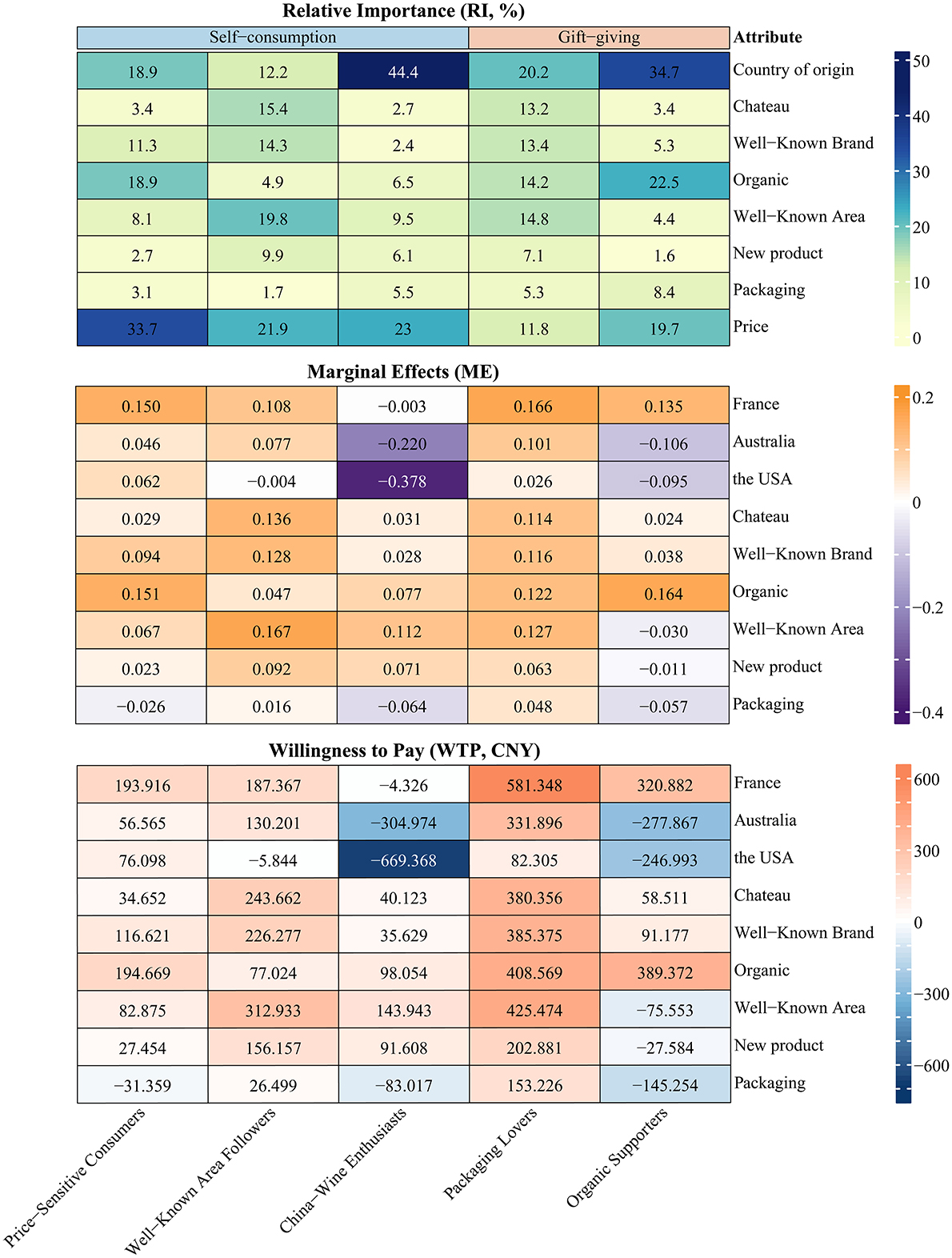
Figure 4. Integrated heatmap of attribute relative importance, marginal effects, and willingness to pay across consumer segments and consumption contexts.
In the self-consumption context, “Price-Sensitive Consumers” (Class 1, 12.5%) exhibit the highest price sensitivity across segments (RI = 33.7%). However, their relatively high willingness to pay for organic labels (194.669 CNY) and French wine (193.916 CNY) indicates a preference for familiar and trusted attributes, likely driven by perceived quality and reliability, which does not diminish their overall price sensitivity. Comprising younger men with limited wine knowledge, their constrained resources and expertise explain this price focus and reliance on familiar organic and COO cues. “Well-Known Area Followers” (Class 2, 26.2%) prioritize the well-known area attribute (RI = 19.8%, ME = 0.176, WTP = 312.933 CNY), showing preferences for Chateau and new products. Young, lower-income individuals dominate this group, reflecting a blend of quality-seeking, eco-friendly and novelty interest. “China-Wine Enthusiasts” (Class 3, 61.3%) strongly prefer Chinese wines, differing from all segments, with COO having the greatest influence (RI = 44.4%). They show aversion to Australia and The USA, and indifference to France. Well-known area also matters (ME = 0.112, WTP = 143.943 CNY), indicating quality sensitivity among this largest segment.
In the gift-giving context, “Packaging Lovers” (Class 1, 81.1%) uniquely value packaging (WTP = 153.226 CNY). With lower price sensitivity, they exhibit higher WTP across attributes compared to other classes. All marginal effects are positive, indicating that each attribute increases purchase probability. This segment, likely comprising younger non-private sector workers, shows a strong preference for presentation over cost, reflecting a desire to enhance “face” and prestige. “Organic Supporters” (Class 2, 18.9%) prioritize organic labels (ME = 0.164, WTP = 389.372 CNY), with a high WTP for French COO (320.882 CNY), while other reputational attributes offer no utility and reject packaging.
To facilitate comparison across segments and highlight context-specific vs. shared preferences, Figure 5 summarizes the key attributes associated with each latent class identified under the self-consumption and gift-giving scenarios.
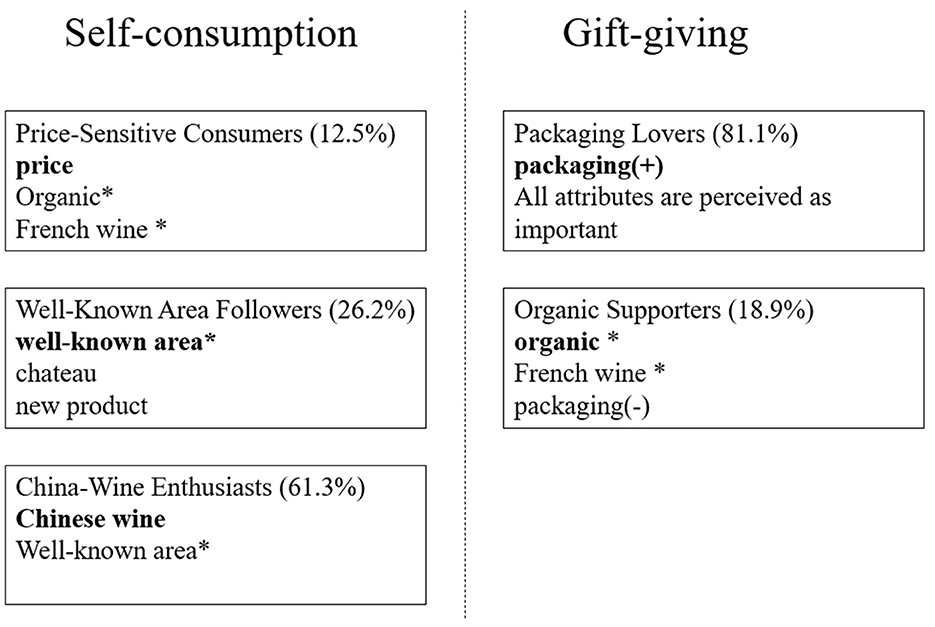
Figure 5. Summary of key attribute preferences across latent consumer segments in self-consumption and gift-giving contexts [(*) indicate attributes that appear in more than one segment, highlighting shared importance across contexts].
5 Discussion
A key finding of this study is that preferences for packaging reveal a clear divergence in behavior across self-consumption and gift-giving scenarios. In self-consumption, “China-Wine Enthusiasts” and “Price-Sensitive Consumers” reject packaging, indicating a need for tailored strategies emphasizing minimal or eco-friendly packaging to support sustainable consumption goals in this context. In gift-giving, packaging preferences are also inconsistent. “Packaging Lovers” highly value delicate packaging, while “Organic Supporters” show disutility. This is inconsistent with findings based on first-tier and second-tier cities that emphasize the importance of delicate packaging in gift-giving (Yang and Paladino, 2015). For “Packaging Lovers,” marketing strategies can be promoted across regions. Demographic trends in this group, such as a higher share of young and high-income respondents, may further explain their strong preference for packaging. These consumers are more likely to associate premium packaging with social value, aligning with the symbolic role of wine gifts in Chinese culture. Without segmenting consumers, these differences may remain unrecognized, limiting opportunities for effective marketing.
Organic attributes offer additional insights into behavioral drivers of sustainable consumption, with broad applicability across China's wine markets. In the gift-giving context, “Organic Supporters” prioritize organic labels, which is consistent with trends observed in broader Chinese markets (Lu et al., 2019; Chi et al., 2021). Even “Price-Sensitive Consumers” buying for themselves prefer organic labels. This suggests that organic label may be considered a more trustworthy signal than other reputational indicators in less developed wine markets. One possible explanation is that people in these regions have less wine knowledge compared to those in first-tier cities, while certifications are easy to recognize. These findings suggest that organic labels can appeal to both budget-conscious buyers and quality-driven gift-givers, offering a solid foundation for sustainable marketing across different consumer segments.
The COO preference of consumers in Chengdu and Xi'an was also a surprising result, overturning earlier ideas that Chinese consumers predominantly prefer imported wines, especially from France (Xu and Zeng, 2014; Capitello et al., 2015; Gonçalves et al., 2020; Christian and Wang, 2022). While gift-giving still favors French wines, self-consumption tells a different story. A large segment of respondents now prefers local wines, showing little interest in French ones and avoiding Australia or American options. This trend for local wines in these cities may be driven by better distribution and marketing by local wine industries (Lockshin and Cohen, 2020). It reinforces consumers' ethnocentrism and familiarity with the product (Petek et al., 2021). Local wine marketing could thrive in these cities, while foreign brands might need more local investment and marketing.
The five consumer segments identified in this study offer a useful basis for targeted marketing strategies, which may also apply to areas beyond second-tier cities. For Price-Sensitive Consumers, affordable organic wines with simple but credible certifications and COO labels should be emphasized. These products can be distributed through online channels, accompanied by short-form educational content to enhance product confidence. For Well-Known Area Followers, marketers may focus on wines from geographically recognized regions, incorporating wineries with compelling stories, limited editions, and visually appealing but cost-effective packaging to capture their interest in novelty and quality cues. For “China-Wine Enthusiasts,” marketers should highlight the quality, cultural relevance, and affordability of Chinese wines. Foreign brands, facing lower acceptance, may appeal to this group by emphasizing well-known origins and offering competitive prices to reduce perceived unfamiliarity. “Packaging Lovers,” who associate packaging with prestige and gifting value, should be targeted with premium gift sets that feature recyclable or wooden boxes, positioned during festivals and special occasions. Messaging should highlight both luxury and sustainability. For “Organic Supporters,” marketing should downplay packaging and instead emphasize clean labeling, certification logos, and messages about health, environmental benefits, and traceability—possibly integrated into QR codes.
While these strategies are derived from second-tier cities, many of the underlying value drivers—such as price sensitivity, sustainability awareness, and identity signaling—also exist in first-tier markets, particularly among younger consumers. With appropriate adaptation in brand tone, channel selection, and promotional context, these segmentation-based strategies have the potential to scale across different regions in China's evolving wine market.
6 Conclusions
This study employs DCEs and LCMs to investigate sustainable wine preferences in China, identifying five distinct consumer segments across self-consumption and gift-giving contexts: “Price-Sensitive Consumers,” “Well-Known Area Followers,” and “China-Wine Enthusiasts” in the former, and “Packaging Lovers” and “Organic Supporters” in the latter. The findings reveal that while organic certification is broadly valued, its appeal varies—from a marker of health and quality for “Organic Supporters” to a trusted signal for “Price-Sensitive Consumers.” Packaging preferences also show sharp contextual and intra-contextual differences: while self-consumption segments tend to reject packaging, attitudes toward it in gift-giving are mixed. “Packaging Lovers” emphasize elaborate presentation for its symbolic and social value, whereas “Organic Supporters” actively reject packaging as environmentally wasteful. Unlike consumers in first-tier cities, many self-drinkers in Chengdu and Xi'an tend to favor local wines. This suggests that effective wine marketing in China should take into account different consumer segments, consumption scenarios, and regions.
This study has some potential limitations. First, while WTP estimates for self-consumption appear reliable, those for gift-giving may be inflated, possibly due to social desirability bias in reflecting generosity (Boncinelli et al., 2019). Although “cheap talk” scripts reduced hypothetical bias in self-consumption, they were less effective in gift-giving, suggesting a need for refined methods to address such biases in future research. Second, future research should explore psychosocial factors, such as environmental attitudes, and assess the long-term impact of marketing strategies. Wineries should leverage these insights to adopt sustainable practices, aligning with China's growing demand for eco-friendly products and contributing to global sustainable food systems.
Data availability statement
The raw data supporting the conclusions of this article will be made available by the authors, without undue reservation.
Author contributions
DH: Conceptualization, Project administration, Validation, Writing – review & editing, Formal analysis, Investigation, Data curation, Writing – original draft. YD: Methodology, Investigation, Software, Writing – original draft. YZ: Supervision, Funding acquisition, Writing – review & editing, Conceptualization.
Funding
The authors declare that financial support was received for the research and/or publication of this article. This study was supported by the State Key Program of National Natural Science of China (Grant No. 71633005) and the Scientific Research Fund of Renmin University of China (Grant No. 413122907021).
Conflict of interest
The authors declare that the research was conducted in the absence of any commercial or financial relationships that could be construed as a potential conflict of interest.
Generative AI statement
The author(s) declare that no Gen AI was used in the creation of this manuscript.
Publisher's note
All claims expressed in this article are solely those of the authors and do not necessarily represent those of their affiliated organizations, or those of the publisher, the editors and the reviewers. Any product that may be evaluated in this article, or claim that may be made by its manufacturer, is not guaranteed or endorsed by the publisher.
Supplementary material
The Supplementary Material for this article can be found online at: https://www.frontiersin.org/articles/10.3389/fsufs.2025.1615703/full#supplementary-material
Footnotes
1. ^The purpose of the “cheap talk” is to guide respondents to reveal their real preferences, to make them aware of the existence of hypothetical bias, and to remind them of their limited budget. Specifically, “Please forget for a moment that this is a survey experiment and make your choice as if you were actually ordering and paying online. Although you are not required to actually pay, please don't pretend to be ‘generous' by doing so. Please make a choice after considering your actual ability to pay.”
2. ^The “trap” question, also known as a validation question, directly requires respondents to choose a specific answer to a question. In the Likert scale of this study, respondents were presented with the question, “To ensure data quality, please choose ‘Strongly Disagree' to answer this question.” The questionnaires with responses that did not follow the instructions were excluded.
3. ^Set the option with a minimum probability of occurrence in the multiple-choice question. The questionnaires with responses selecting this option were excluded.
4. ^After the respondents completed the choice sets, the system randomly selected a choice set that was previously answered for them to answer again. The questionnaires with inconsistent responses were excluded.
References
Adamowicz, W., Boxall, P., Williams, M., and Louviere, J. (1998). Stated preference approaches for measuring passive use values: choice experiments and contingent valuation. Am. J. Agric. Econ. 80, 64–75. doi: 10.2307/3180269
Anderson, K. (2020). Asia's emergence in global beverage markets: the rise of wine. Singapore Econ. Rev. 65, 755–779. doi: 10.1142/S0217590820500162
Anderson, K. (2023). What's happened to the wine market in China? J. Wine Econ. 18, 173–183. doi: 10.1017/jwe.2023.16
Anderson, K., and Wittwer, G. (2015). Asia's evolving role in global wine markets. China Econ. Rev. 35, 1–14. doi: 10.1016/j.chieco.2015.05.003
Aqueveque, C. (2022). Consumers' preferences for low-priced wines' packaging alternatives: the influence of consumption occasion, gender, and age. Br. Food J. 125, 781–793. doi: 10.1108/BFJ-09-2021-1040
Boncinelli, F., Dominici, A., Gerini, F., and Marone, E. (2019). Consumers wine preferences according to purchase occasion: personal consumption and gift-giving. Food Qual. Prefer. 71, 270–278. doi: 10.1016/j.foodqual.2018.07.013
Brochado, A., Rodrigues, H., and Mendes, S. V. (2024). “Message in a bottle: generation Y and wine purchase occasions' perceived risks and information sources,” in Strategic Management in the Wine Tourism Industry: Competitive Strategies, Wine Tourism Behaviour and New Strategic Tools (Cham: Palgrave Macmillan), 91–111. doi: 10.1007/978-3-031-54837-6_5
Bruwer, J., Fong, M., and Saliba, A. (2013). Perceived risk, risk-reduction strategies (RRS) and consumption occasions. Asia Pac. J. Market. Logist. 25, 369–390. doi: 10.1108/APJML-06-2012-0048
Camillo, A. A. (2012). A strategic investigation of the determinants of wine consumption in China. Int. J. Wine Business Res. 24, 68–92. doi: 10.1108/17511061211213792
Capitello, R., Agnoli, L., and Begalli, D. (2015). Chinese import demand for wine: evidence from econometric estimations. J. Wine Res. 26, 115–135. doi: 10.1080/09571264.2015.1014547
Carlsson, F., Frykblom, P., and Lagerkvist, C. J. (2005). Using cheap talk as a test of validity in choice experiments. Econ. Lett. 89, 147–152. doi: 10.1016/j.econlet.2005.03.010
Carsana, L., and Jolibert, A. (2017). The influence of brand schematicity on the importance of product cues: self-purchasing versus gift-giving situations. J. Cons. Market. 34, 255–267. doi: 10.1108/JCM-07-2016-1869
Chalak, A., Balcombe, K., Bailey, A., and Fraser, I. (2008). Pesticides, preference heterogeneity and environmental taxes. J. Agric. Econ. 59, 537–554. doi: 10.1111/j.1477-9552.2008.00163.x
Chamorro, A., García-Gallego, J. M., and Trindade-Carlos, H. C. (2020). Study on the importance of wine bottle design on consumer choices. Br. Food J. 123, 577–593. doi: 10.1108/BFJ-03-2020-0244
Chamorro, A., Rubio, S., and Miranda, F. J. (2015). The region-of-origin (ROO) effect on purchasing preferences. Br. Food J. 117, 820–839. doi: 10.1108/BFJ-03-2014-0112
Chi, C. G.-Q., Ouyang, Z., Lu, L., and Zou, R. (2021). Drinking “Green”: what drives organic wine consumption in an emerging wine market. Cornell Hosp. Quart. 62, 516–534. doi: 10.1177/1938965520943193
Christian, J. E., and Wang, D. (2022). Bias behind closed doors: Chinese consumers' perception of foreign wines. J. Cons. Behav. 21, 1318–1333. doi: 10.1002/cb.2093
Corsi, A. M., Cohen, J., and Lockshin, L. (2017a). China: consumption occasion affects how Chinese consumers buy wine. Wine Viticult. J. 32, 63–64.
Corsi, A. M., Cohen, J., and Lockshin, L. (2017b). “How consumptions occasions shape consumer preferences: a discrete choice experiment approach,” in: 10Th International Conference of the Academy of Wine Business Research (Rohnert Park, CA: Sonoma State University).
Dhar, R. (1997). Consumer preference for a no-choice option. J. Cons. Res. 24, 215–231. doi: 10.1086/209506
Dhar, R., and Simonson, I. (2003). The effect of forced choice on choice. J. Market. Res. 40, 146–160. doi: 10.1509/jmkr.40.2.146.19229
Di Vita, G., Pappalardo, G., Chinnici, G., La Via, G., and D'Amico, M. (2019). Not everything has been still explored: further thoughts on additional price for the organic wine. J. Clean. Prod. 231, 520–528. doi: 10.1016/j.jclepro.2019.05.268
Ding, Y., Nayga, R. M. Jr., Zeng, Y., Yang, W., and Snell, H. A. (2022). Consumers' valuation of a live video feed in restaurant kitchens for online food delivery service. Food Policy 112:102373. doi: 10.1016/j.foodpol.2022.102373
Dobele, A. R., Greenacre, L., and Fry, J. (2018). The impact of purchase goal on wine purchase decisions. Int. J. Wine Business Res. 30, 19–41. doi: 10.1108/IJWBR-07-2016-0021
Dominici, A., Boncinelli, F., Gerini, F., and Marone, E. (2019). Consumer preference for wine from hand-harvested grapes. Br. Food J. 122, 2551–2567. doi: 10.1108/BFJ-04-2019-0301
Dong, Y., and Gao, L. (2024). Consumer attitude and behavioural intention towards organic wine: the roles of consumer values and involvement. Br. Food J. 126, 1743–1764. doi: 10.1108/BFJ-02-2023-0085
Escobar, C., Kallas, Z., and Gil, J. M. (2018). Consumers' wine preferences in a changing scenario. Br. Food J. 120, 18–32. doi: 10.1108/BFJ-02-2017-0070
Farrell, J., and Rabin, M. (1996). Cheap talk. J. Econ. Perspect. 10, 103–118. doi: 10.1257/jep.10.3.103
Gao, Z., House, L., and Bi, X. (2016a). Impact of satisficing behavior in online surveys on consumer preference and welfare estimates. Food Policy 64, 26–36. doi: 10.1016/j.foodpol.2016.09.001
Gao, Z., House, L. A., and Xie, J. (2016b). Online survey data quality and its implication for willingness-to-pay: a cross-country comparison. Can. J. Agric. Econ. 64, 199–221. doi: 10.1111/cjag.12069
Gonçalves, T., Lourenço-Gomes, L., and Pinto, L. (2020). Modelling consumer preferences heterogeneity in emerging wine markets: a latent class analysis. Appl. Econ. 52, 6136–6144. doi: 10.1080/00036846.2020.1784389
Green, P. E., and Rao, V. R. (1971). Conjoint measurement-for quantifying judgmental data. J. Market. Res. 8, 355–363. doi: 10.1177/002224377100800312
Greene, W. H., and Hensher, D. A. (2003). A latent class model for discrete choice analysis: contrasts with mixed logit. Transp. Res. Part B Methodol. 37, 681–698. doi: 10.1016/S0191-2615(02)00046-2
Hensher, D. A., Rose, J. M., and Greene, W. H. (2015). Applied Choice Analysis. Cambridge: Cambridge University Press. doi: 10.1017/CBO9781316136232
HKTDC. (2018). Consumption Characteristics of the Chinese Wine Market. Available online at: https://research.hktdc.com/sc/article/NDMxNDIxODA2 (accessed March 18, 2025).
HKTDC. (2020). China Wine and Spirits Consumption Survey. Available online at: https://research.hktdc.com/sc/article/NTk4MTYzNzUx (accessed March 18, 2025).
Hoyos, D. (2010). The state of the art of environmental valuation with discrete choice experiments. Ecol. Econ. 69, 1595–1603. doi: 10.1016/j.ecolecon.2010.04.011
Hu, L., and Baldin, A. (2018). The country of origin effect: a hedonic price analysis of the Chinese wine market. Br. Food J. 120, 1264–1279. doi: 10.1108/BFJ-02-2017-0121
Hu, X., Li, L., Xie, C., and Zhou, J. (2008). The effects of country-of-origin on Chinese consumers' wine purchasing behaviour. J. Technol. Manag. China 3, 292–306. doi: 10.1108/17468770810916195
Huiru, W., Zhijian, Z., Jianying, F., Dong, T., and Weisong, M. (2018). Influencing factors on chinese wine consumers'behavior under different purchasing motivations based on a multi-classification method. Ital. J. Food Sc. 30 775–791. doi: 10.14674/IJFS-1182
Janssen, M., Schäufele, I., and Zander, K. (2020). Target groups for organic wine: the importance of segmentation analysis. Food Qual. Prefer. 79:103785. doi: 10.1016/j.foodqual.2019.103785
Jones, M. S., House, L. A., and Gao, Z. (2015). Respondent screening and revealed preference axioms: testing quarantining methods for enhanced data quality in web panel surveys. Public Opin. Q. 79, 687–709. doi: 10.1093/poq/nfv015
Kallas, Z., Escobar, C., and Gil, J. M. (2013). Analysis of consumers' preferences for a special-occasion red wine: a dual response choice experiment approach. Food Qual. Prefer. 30, 156–168. doi: 10.1016/j.foodqual.2013.05.008
Lindhjem, H., and Navrud, S. (2011). Using internet in stated preference surveys: a review and comparison of survey modes. Int. Rev. Environ. Resour. Econ.. 5, 309–351. doi: 10.1561/101.00000045
Lockshin, L., and Cohen, J. (2020). “Wine trends in China,” in Handbook of Eating and Drinking: Interdisciplinary Perspectives (Cham: Springer), 575–592. doi: 10.1007/978-3-030-14504-0_166
Lockshin, L., Jarvis, W., d'Hauteville, F., and Perrouty, J.-P. (2006). Using simulations from discrete choice experiments to measure consumer sensitivity to brand, region, price, and awards in wine choice. Food Qual. Prefer. 17, 166–178. doi: 10.1016/j.foodqual.2005.03.009
Louviere, J. J., Hensher, D. A., and Swait, J. D. (2000). Stated Choice Methods: Analysis and Applications. Cambridge: Cambridge University Press. doi: 10.1017/CBO9780511753831
Lu, L., Chi, C. G.-Q., and Zou, R. (2019). Determinants of Chinese consumers' organic wine purchase. Int. J. Contemp. Hosp. Manag. 31, 3761–3778. doi: 10.1108/IJCHM-02-2019-0118
Lusk, J. L., and Schroeder, T. C. (2004). Are choice experiments incentive compatible? A test with quality differentiated beef steaks. Am. J. Agric. Econ. 86, 467–482. doi: 10.1111/j.0092-5853.2004.00592.x
Mackenzie, M., Weber, K., Fountain, J., and Abbasi, R. (2024). Segmenting Chinese wine consumers on the basis of wine knowledge and consumption behavior. Int. J. Wine Business Res. 37, 233–255. doi: 10.1108/IJWBR-06-2023-0035
Masson, J., Sánchez, C. R. S., and Celhay, F. (2017). Is mianzi the only face of Chinese consumers of wine?: a typology of chinese consumers of imported wine. Int. J. Market Res. 59, 625–654. doi: 10.2501/IJMR-2017-044
Mu, W., Zhu, H., Tian, D., and Feng, J. (2017). Profiling wine consumers by price segment: a case study in Beijing, China. Ital. J. Food Sc. 29, 377–397. doi: 10.14674/1120-1770/ijfs.v626
Mueller, S., Lockshin, L., Saltman, Y., and Blanford, J. (2010). Message on a bottle: the relative influence of wine back label information on wine choice. Food Qual. Prefer. 21, 22–32. doi: 10.1016/j.foodqual.2009.07.004
Nassivera, F., Gallenti, G., Troiano, S., Marangon, F., Cosmina, M., Bogoni, P., et al. (2020). Italian millennials' preferences for wine: an exploratory study. Br. Food J. 122, 2403–2423. doi: 10.1108/BFJ-05-2019-0306
Nielsen, J. S. (2011). Use of the Internet for willingness-to-pay surveys: a comparison of face-to-face and web-based interviews. Resour. Energy Econ. 33, 119–129. doi: 10.1016/j.reseneeco.2010.01.006
OIV. (2023). Evolution of World Wine Production and Consumption by Colour. Paris: International Organisation of Vine and Wine (OIV). Available online at: https://www.oiv.int/sites/default/files/documents/OIV-FOCUS-2023_Evolution_of_the_world_wine_production_and_consumption_by_colour_5.pdf
OIV. (2024). State of the World Vine and Wine Sector in 2023. Paris: International Organisation of Vine and Wine (OIV). Available online at: https://www.oiv.int/sites/default/files/2024-04/OIV_STATE_OF_THE_WORLD_VINE_AND_WINE_SECTOR_IN_2023.pdf
Palma, D., Ortúzar, J. d. D., Rizzi, L. I., Guevara, C. A., Casaubon, G., et al. (2016). Modelling choice when price is a cue for quality: a case study with Chinese consumers. J. Choice Modell. 19, 24–39. doi: 10.1016/j.jocm.2016.06.002
Petek, V., Rozman, C., and Potočnik Topler, J. (2021). When the customer and the wine shelf meet: factors of ethnocentrism when selecting a bottle of wine. Sustainability 13:12098. doi: 10.3390/su132112098
Qing, P., Xi, A. Q., and Hu, W. Y. (2015). Self-consumption, gifting, and Chinese wine consumers. Can. J. Agric. Econ. 63, 601–620. doi: 10.1111/cjag.12086
Revilla, M., and Höhne, J. K. (2020). How long do respondents think online surveys should be? New evidence from two online panels in Germany. Int. J. Market Res. 62, 538–545. doi: 10.1177/1470785320943049
Sáenz-Navajas, M.-P., Ballester, J., Peyron, D., and Valentin, D. (2014). Extrinsic attributes responsible for red wine quality perception: a cross-cultural study between France and Spain. Food Qual. Prefer. 35, 70–85. doi: 10.1016/j.foodqual.2014.02.005
Schäufele, I., and Hamm, U. (2017). Consumers' perceptions, preferences and willingness-to-pay for wine with sustainability characteristics: a review. J. Clean. Prod. 147, 379–394. doi: 10.1016/j.jclepro.2017.01.118
Seidemann, V., Atwal, G., and Heine, K. (2017). “Gift culture in China: consequences for the fine wine sector,” in The Wine Value Chain in China (Oxford: Chandos Publishing), 47–61. doi: 10.1016/B978-0-08-100754-9.00004-0
Street, D. J., and Burgess, L. (2007). The Construction of Optimal Stated Choice Experiments: Theory and Methods. Hoboken, NJ: John Wiley and Sons. doi: 10.1002/9780470148563
Tait, P., Saunders, C., Dalziel, P., Rutherford, P., Driver, T., and Guenther, M. (2019). Estimating wine consumer preferences for sustainability attributes: a discrete choice experiment of Californian Sauvignon blanc purchasers. J. Clean. Prod. 233, 412–420. doi: 10.1016/j.jclepro.2019.06.076
Train, K. E. (2009). Discrete Choice Methods With Simulation. Cambridge: Cambridge University Press.
Wang, M. (2017). A Comparative Study of Wine Consumer Behavior in China and the United States: Does Culture Affect Consumer Behavior? Master's Thesis, Pomona: California State Polytechnic University. Available online at: https://scholarworks.calstate.edu/concern/projects/dz010s27n
Williamson, P. O., Lockshin, L., Francis, I. L., and Loose, S. M. (2016). Influencing consumer choice: short and medium term effect of country of origin information on wine choice. Food Qual. Prefer. 51, 89–99. doi: 10.1016/j.foodqual.2016.02.018
Windle, J., and Rolfe, J. (2011). Comparing responses from internet and paper-based collection methods in more complex stated preference environmental valuation surveys. Econ. Anal. Policy 41, 83–97. doi: 10.1016/S0313-5926(11)50006-2
Xu, P., and Zeng, Y. C. (2014). Factors that affect willingness to pay for red wines in China. J. Int. Cons. Market. 26, 426–439. doi: 10.1080/08961530.2014.928606
Xu, P., Zeng, Y. C., Song, S., and Lone, T. (2014). Willingness to pay for red wines in China. J. Wine Res. 25, 265–280. doi: 10.1080/09571264.2014.963217
Yang, Y., and Paladino, A. (2015). The case of wine: understanding Chinese gift-giving behavior. Mark. Lett. 26, 335–361. doi: 10.1007/s11002-015-9355-0
Yu, H., and Ruimei, W. (2019). A clustered-based segmentation of Chinese wine consumers by means of Kernal Fuzzy C-means. Ital. J. Food Sci. 31, 764–781. doi: 10.14674/IJFS-1512
Yu, Y., Sun, H., Goodman, S., Chen, S., and Ma, H. (2009). Chinese choices: a survey of wine consumers in Beijing. Int. J. Wine Business Res. 21, 155–168. doi: 10.1108/17511060910967999
Zanchini, R., Blanc, S., Theodorakis, S., Di Vita, G., Merlino, V. M., Brun, F., et al. (2024). How European consumers value wine credence attributes: a cross-country comparison of France, Greece and Italy. Wine Econ. Policy. doi: 10.36253/wep-15235
Zhou, J., Liu, Q., Mao, R., and Yu, X. (2017). Habit spillovers or induced awareness: willingness to pay for eco-labels of rice in China. Food Policy 71, 62–73. doi: 10.1016/j.foodpol.2017.07.006
Appendix A. Econometric specifications
Latent Class Model (LCM)
In this study, there are two scenarios of self-consumption and gift-giving. Thus, the utility U of consumer i in class s choosing alternative j in scenarios k (k =1 for self-consumption, k =2 for gift-giving) (Chalak et al., 2008), is expressed as:
Where is the scenario-specific attribute vector (including price ) and non-price attribute ), assumed identical across scenarios; is the corresponding parameter vector, reflecting preferences within class s, and consistent across both scenarios; is the scenario-specific random error term, capturing unobserved heterogeneity for each scenario.
The probability that consumer i in class s choosing alternative j in scenarios k from a choice set J(k) is expressed as:
Relative Importance (RI)
The RI of attribute x in class s for scenario k (Green and Rao, 1971; Louviere et al., 2000), is expressed as
Where is the absolute value of the parameter for attribute x in class s and scenario k, reflecting its utility impact; is the range of attribute x in scenario k, capturing its practical variation; denominator normalizes the contribution across all attributes in scenario k, which allows comparison across attributes, expressing importance as a proportion.
Marginal Effects (ME)
Given that our attributes include a continuous variable and other discrete variables (non-price attribute), the marginal effect calculation differs by attribute type (Greene and Hensher, 2003; Train, 2009).
For price , the marginal effect is the partial derivative of the probability with respect to price, assuming it affects only alternative j′ utility (own-effect):
For each dummy variable (non-price attribute), the marginal effect is the discrete change in probability when shifts from 0 to 1:
Willingness to Pay (WTP)
WTP for a non-price attribute is derived as:
Based on our utility function, WTP estimates are estimated as follows:
To calculate the confidence intervals, we used the delta method to generate the empirical distribution of the WTP (Greene and Hensher, 2003).
Keywords: sustainable wine, consumer preferences, Chinese market, choice experiment, Latent Class Model
Citation: Hu D, Ding Y and Zeng Y (2025) Sustainable wine preferences in China: scenario-specific insights for self-consumption and gift-giving. Front. Sustain. Food Syst. 9:1615703. doi: 10.3389/fsufs.2025.1615703
Received: 21 April 2025; Accepted: 24 June 2025;
Published: 14 July 2025.
Edited by:
Amar Razzaq, Huanggang Normal University, ChinaCopyright © 2025 Hu, Ding and Zeng. This is an open-access article distributed under the terms of the Creative Commons Attribution License (CC BY). The use, distribution or reproduction in other forums is permitted, provided the original author(s) and the copyright owner(s) are credited and that the original publication in this journal is cited, in accordance with accepted academic practice. No use, distribution or reproduction is permitted which does not comply with these terms.
*Correspondence: Yinchu Zeng, emVuZ3ljQHJ1Yy5lZHUuY24=
 Ding Hu
Ding Hu Ye Ding
Ye Ding